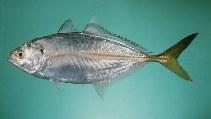| Family: |
Carangidae (Jacks and pompanos), subfamily: Caranginae |
| Max. size: |
40 cm TL (male/unsexed); max.weight: 603.0 g |
| Environment: |
reef-associated; marine, amphidromous |
| Distribution: |
Indo-Pacific: Red Sea and East Africa (Ref. 12484) to the Hawaiian Islands, north to Japan, south to Australia. Immigrant to the eastern Mediterranean through the Suez Canal, wetward to Malta (Ref. 33971). |
| Diagnosis: |
Dorsal spines (total): 9-9; Dorsal soft rays (total): 22-25; Anal spines: 3-3; Anal soft rays: 18-20. Description: Greyish green above, silvery to white below; distinct black blotch on upper margin of opercle, bordered above by a smaller white spot; caudal fin yellowish, upper lobe dusky to black distally (Ref. 3197). Body with dorsal and ventral profiles almost evenly convex. Adipose eyelid well-developed on posterior half of the eye. LL with 0-3 scales on straight part and 31-36 scales on curved part and 39-51 scutes. (Ref. 90102) |
| Biology: |
Adults form large schools near inshore reefs (Ref. 30573). Feed on shrimps, copepods, decapod larvae and other crustacean larvae and small fish (Ref. 5213, 90102). Eggs are pelagic (Ref. 4233). Often caught by ski-boat anglers in southern Africa (Ref. 12484). |
| IUCN Red List Status: |
Least Concern (LC); Date assessed: 06 March 2015 Ref. (130435)
|
| Threat to humans: |
harmless |
Source and more info: www.fishbase.org. For personal, classroom, and other internal use only. Not for publication.

